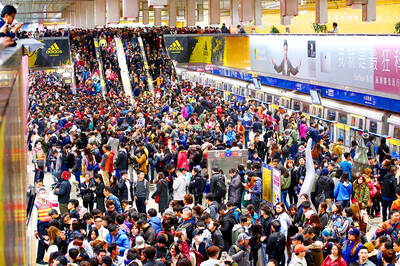Local paper producers have pledged to step up investment in the research and development of technologies that could enable Taiwan to fully recycle its paper waste of 140,000 tonnes per year.
Taiwanese use about 8 billion paper containers per year, and many people assume that they can be fully recycled, the Environmental Protection Administration said.
Despite government efforts to raise awareness about the correct disposal of garbage, 12 to 15 percent of items collected for paper recycling are not suitable, according to the companies involved in the effort, which include Cheng Loong Corp, Chung Hwa Pulp Corp.
Corporate representatives said that laminated and non-laminated paper items must be recycled separately, adding that only the latter can be recycled into containers for food.
Recycling laminated items is more complicated, as the layers have to be separated, they said.
Separating the layers during recycling does not cause environmental damage, Cheng Loong said.
However, it is easiest to use fresh pulp to make paper containers for food, it added.
Cheng Loong said it last year recycled 30,000 tonnes of laminated paper products, adding that materials used in their insulation layers were processed into fuel to power paper mills.
Chung Hwa said products sold under its CircuWell brand, which are mainly exported or sold to airlines, are easier to recycle into paper cups and other containers.
Its products use a heat and oil-resistant coating that is different from insulation materials used by other companies, the company said, adding that its products meet food safety regulations in Taiwan and the US.

People can take the Taipei MRT free of charge if they access it at Nanjing Sanmin Station or Taipei Arena Station on the Green Line between 12am and 6am on Jan. 1, the Taipei Department of Transportation said on Friday, outlining its plans to ease crowding during New Year’s events in the capital. More than 200,000 people are expected to attend New Year’s Eve events in Taipei, with singer A-mei (張惠妹) performing at the Taipei Dome and the city government’s New Year’s Eve party at Taipei City Hall Plaza, the department said. As people have tended to use the MRT’s Blue or

Civil society groups yesterday protested outside the Legislative Yuan, decrying Chinese Nationalist Party (KMT) efforts to pass three major bills that they said would seriously harm Taiwan’s democracy, and called to oust KMT caucus whip Fu Kun-chi (傅?萁). It was the second night of the three-day “Bluebird wintertime action” protests in Taipei, with organizers announcing that 8,000 people attended. Organized by Taiwan Citizen Front, the Economic Democracy Union (EDU) and a coalition of civil groups, about 6,000 people began a demonstration in front of KMT party headquarters in Taipei on Wednesday, organizers said. For the third day, the organizers asked people to assemble

Taipei is participating in Osaka’s Festival of Lights this year, with a 3m-tall bubble tea light installation symbolizing Taiwan’s bubble tea culture. The installation is designed as a bubble tea cup and features illustrations of Taipei’s iconic landmarks, such as Taipei 101, the Red House and North Gate, as well as soup dumplings and the matchmaking deity the Old Man Under the Moon (月下老人), affectionately known as Yue Lao (月老). Taipei and Osaka have collaborated closely on tourism and culture since Taipei first participated in the festival in 2018, the Taipei City Department of Information and Tourism said. In February, Osaka represented

Taiwanese professional baseball should update sports stadiums and boost engagement to enhance fans’ experience, Chinese Professional Baseball League (CPBL) commissioner Tsai Chi-chang (蔡其昌) told the Liberty Times (sister paper of the Taipei Times) in an interview on Friday. The league has urged Farglory Group and the Taipei City Government to improve the Taipei Dome’s outdated equipment, including relatively rudimentary television and sound systems, and poor technology, he said. The Tokyo Dome has markedly better television and sound systems, despite being 30 years old, because its managers continually upgraded its equipment, Tsai said. In contrast, the Taipei Dome lacked even a room for referees